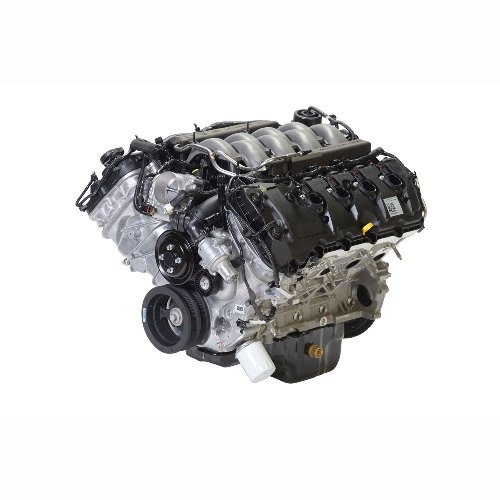Everything You Need to Know about Mod Motors

The Mod V8 may have been looked down on when it first reached the Mustang in 1996, but over 14 years, engineers found new ways to squeeze more power out of this overhead cam engine. What’s the differences between these versions of the engine, and which ones are best for building a project car?
Why is it called a “Mod” motor?
The nickname is short for “modular.” The overhead cam V8s used in the Mustang
were part of a new way for Ford to build different engines ranging from Duratec
V6’s to Aston Martin V12s using similar tooling to cut costs. Aside this shared
design aspect, these motors don’t share much in common with each other.
The 4.6l Mod Motor in the Mustang
The first Mod motor, an iron block 4.6 liter with two valves per cylinder,
debuted in the 1991 Town Car, offering better performance and fuel economy over
the old 5.0l small block. This engine made its way into the Mustang in 1996.
While horsepower was the same as the old High Output 5.0, low end torque was
lacking and it had very little aftermarket support, giving the engine a bad
reputation early on.
In 1999, Ford came out with the Performance Improvement (P.I.) cylinder head.
Changes to cam timing, intake runners and head design increased power from 225
to 260 hp. This engine was used in the Mustang from ‘99 to ‘04 and Panther
platform cars including the Crown Victoria and Grand Marquis from ‘01 until
they left production.
In 2005, a new three valve per cylinder head was introduced, improving cylinder
head flow and increasing output to 300 hp.
The DOHC 4.6l
Cobras got a dual overhead cam engine with four valves per cylinder in 1996.
This engine uses an aluminum block, swirl port head design and Intake Manifold
Runner Control (IMRC) that uses two sets of intake runners. By only opening the
second set of runners at high RPM, intake velocity is maintained to keep power
up through the rev range. These “B port” heads were used until 1998 and were
rated at 305 hp. From ‘99 to ‘01, the engine used “C port” tumble port heads
and dropped IMRC, increasing output to 320 hp. Versions of the DOHC engine were
also used in the Mach One, Mercury Marauder, Lincoln Aviator and Lincoln Mark
VIII. In ‘03 and ‘04, the DOHC 4.6l returned to the Cobra with an iron block,
supercharger and a freer flowing exhaust, developing 390 hp.
The 5.4l Mod Motor
Like the 4.6l, this larger displacement motor received different head designs
through its lifetime, including two, three and four valve heads. Mostly used in
trucks and SUVs, it found its way into the 2000 Cobra R and 2007-09 Mustang
GT500. DOHC engines were used in Lincoln Navigators from ‘99 to ‘04 with a
rated 300 hp, while the ‘99-04 Lighting uses a SOHC and supercharger to produce
360-380 hp.
The issues with these engines are similar to those faced when dropping a 351W
into a Mustang that was equipped with the 5.0: the added stroke length makes
the motor taller and wider, causing fitment issues, while the low end
torque-focused stock heads limit performance. That said, the accessory mounts
and oil pan are identical, making it an easier swap than the small block.
The Mod Motor Today
Like any new engine, it took a while for tuners and aftermarket manufacturers
to figure out how to get more power out of this design. Its biggest weakness is
head flow, which has been addressed with both aftermarket and Ford’s own head
designs. The iron block and bottom end are extremely strong, letting these
engines handle power that would break a stock 5.0.
The aluminum blocks used in the Cobras came in several versions including
Teksid-built blocks used in ‘96-’96 Cobras and ‘93-’98 Mari VIII’s, Windsor
Aluminum Plant (WAP) blocks used from 2001 to 2004 and improved WAP used with 3
valve heads starting in 2005. The Teksid is the strongest of these, but
problems with the other blocks only show up when making power that is rarely
seen outside of purpose-built dragsters.
The Coyote used in current Mustangs is essentially a heavily updated version of
the Mod motor, making it another swap option. Ford Racing’s new Aluminator use
the Coyote’s parts, resulting in a naturally aspirated engine based on the flat
plane crank Shelby 5.2l producing 580 hp and a low compression motor designed
to work with a supercharger.
Get More Power from Your Mod Motor with
Help from Anderson Ford Motorsport
From our in-house designed intakes to complete crate engines, if it improves
your Mustang’s performance, you can get it from Anderson Ford Motorsport. We’ve
been working on these motors since they were introduced, so we know what Ford
Mustang Performance parts works.
Recent Posts
-
Bringing the Fox Body Mustang into the 21st Century with Holley Terminator X
Anderson Ford Motorsport has been in the Fox Mustang performance industry since 1989. One of the bi …22nd Oct 2021 -
Roush Supercharger install on a 2019 Ford Mustang
Check out this 2019 Ford Mustang before and after we installed a Roush Supercharger. …21st Feb 2020 -
All Blower Installations are not Equal.
Why Should You Choose a Company to Install Your Blower That Has a Dyno Facility In-House?Are all de …24th Jan 2020


